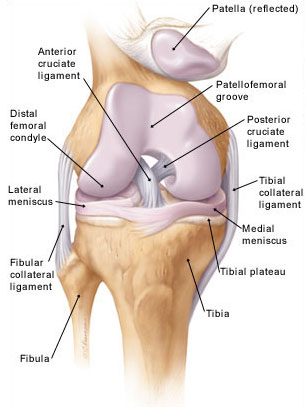ANATOMY OF THE KNEE
In order to understand knee injuries, an understanding is needed of the structure the knee joint.
The knee joint is the largest joint in the body. It is made up of 3 main bones – the femur (thigh bone), the tibia (shin bone), and the patella (kneecap). The end of each is covered in articular cartilage. The body has articular cartilage everywhere that two bony surfaces move against one another, or ‘articulate’. Articular cartilage is ‘slippery’ and so allows the joint surfaces to slide against one another without causing any damage or friction. The function of articular cartilage is to absorb shock and provide an extremely smooth surface to make movement easier. Normal knee function requires a smooth articular cartilage surface on the ends of the bones.
The knee joint capsule is a structure that surrounds the entire knee. Inside this capsule is a membrane known as the synovial membrane which provides nourishment to all the surrounding structures. The knee joint capsule is strengthened by four main ligaments:
- The medial collateral ligament (MCL)
- The lateral collateral ligament (LCL)
- The anterior cruciate ligament (ACL)
- The posterior cruciate ligament (PCL)
Each has a particular function in helping to maintain knee stability in a variety of different positions. The MCL and LCL prevent the knee from moving too far in the side-to-side direction; the ACL and PCL control the front-to-back motion of the knee joint.
The menisci sit between the femur and the tibia. These structures are sometimes referred to as the cartilage of the knee, but the menisci differ from the articular cartilage that covers the surface of the joint. The two menisci of the knee are important for two reasons:
- They work like a shock absorber to spread the force from the weight of the body over a larger area
- They help to lubricate and and satabilize the knee.
The knee joint is not only the largest joint in the body but also the most complex. Due to its position and role, the knee is commonly injured during sporting activities. Common areas of injury to the knee include damage to the articular cartilage, cartilage tears and injuries to the ligaments. The knee is also prone to osteoarthritic (‘wear and tear’) changes later in life.
Common knee terminology
- medial means closer to the midline, so the medial side of the knee is the side that is closest to the other knee.
- lateral is the side that is away from the other knee.
- anterior refers to the front of the knee.
- posterior refers to the back of the knee.

